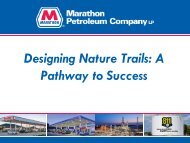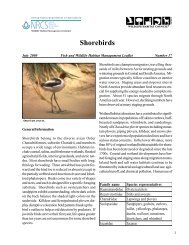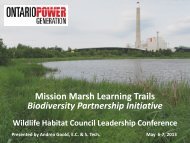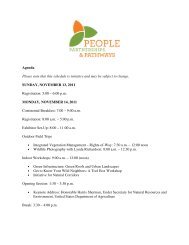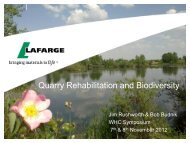Wildlife Habitat Council Wildlife Habitat Council Annual Report 2010 ...
Wildlife Habitat Council Wildlife Habitat Council Annual Report 2010 ...
Wildlife Habitat Council Wildlife Habitat Council Annual Report 2010 ...
Create successful ePaper yourself
Turn your PDF publications into a flip-book with our unique Google optimized e-Paper software.
<strong>Wildlife</strong> <strong>Habitat</strong> <strong>Council</strong><strong>Annual</strong> <strong>Report</strong> <strong>2010</strong>-201120111
Table of Contents• PRESIDENT’S MESSAGE 3• BOARD OF DIRECTORS 4• CERTIFICATION/INTERNATIONAL ACCREDITATION PROGRAM 5• GETTING WILD AT WORK 6• CORPORATE LANDS FOR LEARNING 7• THE BUSINESS OF BIODIVERSITY 8• INTERNATIONAL CONSERVATION AND PARTNER AWARDS 9• ECOSYSTEM SERVICES ON CORPORATE LANDS CONFERENCE 10• GULF COAST REGIONAL CONFERENCE 11• NEW BEGINNINGS – THE WOODLAWN WILDLIFE AREA 12• REGIONAL OFFICES AND INITIATIVES 13• HURON TO ERIE WATERWAYS FOR WILDLIFE PROJECT 14• INTERMOUNTAIN WEST REGIONAL OFFICE 15• NORTHWEST INDIANA – SOUTHEAST CHICAGO OFFICE 16• SOUTHWEST REGIONAL OFFCIE 17• FIVE STAR 18• WHC IN THE COMMUNITY 19• FINANCIALS 202COVER PHOTO © BRIDGESTONE AMERICAS, INC.
President’s MessageThe mission of WHC has always, proudly, been to actively involve people—mostly peoplefrom the private sector—in managing lands to provide enhanced habitat for wildlife. Sinceour beginnings in 1988, our presence has grown to 640 certified<strong>Wildlife</strong> at Work SM programs and 128 Corporate Lands forLearning SM programs in 43 states, the District of Columbia, and 9countries around the world. These programs representmeasurable, sincere efforts on behalf of the private sector tocontribute to public good—benefiting wildlife and community,actively harnessing skill and insight, to contribute to a greenerfuture for all of us.The theme of our work in <strong>2010</strong> was "biodiversity" – the need tounderstand it, and the role each of us can and must play insustaining it. In 2011, we began our focus on the theme of "People, Partnerships andPathways," which builds upon our business and biodiversity focus by looking at all the wayswe are connected to the natural world and exploring ways in which we can work togetheracross public, private and governmental sectors for the preservation of species.To our members, partners, donors and affiliated organizations, thank you for working withus. Through your dedication and leadership efforts, we will continue to promote anecologically whole environment. Together we continue to share a vision to conserve andrestore natural ecosystems for the benefit of humanity and the earth’s biological diversity.My most sincere thanks go to the many volunteer members, governmental and non-profitpartners, and staff who contributed to the creation of this report, the programs describedtherein, and the continuing mission and vision of the <strong>Wildlife</strong> <strong>Habitat</strong> <strong>Council</strong> in the pastyear.Sincerely,Robert JohnsonPresident, <strong>Wildlife</strong> <strong>Habitat</strong> <strong>Council</strong>3
The Board of Directors of the <strong>Wildlife</strong> <strong>Habitat</strong> <strong>Council</strong>ChairmanScott Kilkenny, VP Environmental Health & Safety, Kinder Morgan, Inc.Vice ChairmanLawrence A. Selzer, President, The Conservation FundSecretary-TreasurerGreg Cekander, VP Environmental Management, Waste ManagementImmediate Past ChairmanÉmer ÓBroin, VP Environment, Safety, Health and Human Rights, Monsanto CompanyPast ChairmanDavid W. Carroll, Senior Advisor/Consultant, Lafarge North America Inc.Laurie Davies-Adams, Executive Director, Pollinator PartnershipTim Bent, Director of Environmental Affairs, Bridgestone Americas Holding, Inc.Jack Blackwell, VP of Lands and Conservation, Rocky Mountain Elk FoundationDrew Bradley, Vice President, Environmental Affairs & Asst. General Counsel, Unimin CorporationKevin Butt, General Manager - Chief Environmental Officer,Toyota Motor Manufacturing North America, Inc.David Donaldson, Director, Community Relations, Vulcan Materials CompanyT.G. (Tuss) Erickson, II, P.E., Environmental Health & Safety/HR Director, Ensign United States DrillingLeo Hamilton, Director, Safety, Health & Environment, DuPont CompanyJanet C. Herrin, Vice President, River Operations, Tennessee Valley AuthorityDavid W. Hoskins, Executive Director, Izaak Walton League of AmericaDaniel Hunter, Environmental Manager, ConocoPhillipsPaul P. Krishna, Environmental Programs Manager, ExxonMobil CorporationNiomi Krzystowzcyk, Division Vice President – Health, Safety & Environment, Albemarle CorporationRichard Mire, Corporate Environmental Manager, Exxon Mobil CorporationRobert A. Richard, Senior Vice President, Gas Operations, DTE EnergyHarve Stoeck, Vice President of Environment & Public Affairs, Lafarge North America, Inc.Scott Sutherland, Director of Governmental Affairs, Ducks Unlimited, Inc.Diane Wood, President, National Environmental Education Foundation4
Certification/International Accreditation ProgramIn <strong>2010</strong>, 281 sites were recognized for creating a <strong>Wildlife</strong> at Work SM program, bringing thetotal of currently recognized wildlife programs to 640. In addition, 56 Corporate Lands forLearning SM (CLL) programs were certified or recertified, for a total of 128 conservationeducation programs that reach thousands of learners, from schools and scout groups tomaster gardeners and university researchers. These programs are now found in 43 states,the District of Columbia and nine other countries.http://www.wildlifehc.org/certification/registry-of-existing-programs/The certification program recognizes outstanding wildlife habitat management andenvironmental education efforts and offers third-party validation of the benefits of suchprograms. Certification requirements are strict and require that sites apply for periodicrenewal. http://www.wildlifehc.org/certification/apply/5
Getting Wild at WorkWHC encourages employees to get “Wild at Work” by participating in a wildlife managementteam at their place of employment. WHC’s staff of biologists assists dozens of facilitiesevery year with step by step guides for employees and employers as they establish,develop and manage a wildlife program. When corporations, conservation groups,communities and WHC come together to plan a wildlife habitat enhancement program,<strong>Wildlife</strong> at Work is in action. http://www.wildlifehc.org/programs/wildlife-at-work/PHOTO © ONTARIO POWER GENERATION6
Corporate Lands for LearningEducation is one of the most vital means in ensuring continued wildlife habitat enhancementand sustainable environments. The future of conservation rests in creating opportunities byeducating the public, fostering a sense of stewardship and environmental responsibility.WHC’s Corporate Lands for Learning (CLL) program provides learners of all ages withaccess to corporate lands, natural resources and employee skills through on-site andhands-on environmental education activities to augment traditional classroom teaching.http://www.wildlifehc.org/programs/corporate-lands-for-learning/These programs foster a clear understanding of the interdependence of ecology,economics, social structures and political process in both urban and rural areas.Participants are guided to understand the connection between corporate environmentalinitiatives and their surrounding communities. CLL provides a vehicle for studying localwildlife habitat and promotes an enthusiasm for science, nature and outdoor experiences.The number of Conservation Education Sites (CES) fluctuated slightly in <strong>2010</strong>. WHC sitescan register as a CES, an introductory stage to certification as a CLL program. CESregistration provides recognition of existing programs while placing the program on track forCLL certification. At the end of the fiscal year, 19 programs had registered under CES, while3 programs rolled over into CLL-certified status.http://www.wildlifehc.org/programs/corporate-lands-for-learning/education-sites/WHC’s Education and Outreach Department continued to work closely with the PollinatorPartnership in <strong>2010</strong>. To combat the world-wide loss of pollinators, the Pollinator Task Forcewas created to raise awareness and increase suitable habitat. The Pollinator Partnershipworked with WHC to accomplish habitat and education goals. Pollinator LIVE, a technologybasedseries for educators, began in February of <strong>2010</strong> and continued through the spring of2011, and provided resources for formal or informal educators to teach in or about theirhabitats. Developed by the USDA Forest Service, in partnership with the Prince WilliamCounty (VA) Public Schools, Partners in Resource Education, the National EnvironmentalEducation Foundation and others, Pollinator LIVE was designed for anyone interested inpollinator issues in our environment. Standards-correlated lesson information and tips onhow to integrate pollinators into the classroom, as well as information on how to developprograms, were integral to this series.In <strong>2010</strong>, WHC began its partnership with the Robert Bateman Get to Know Program (G2K).This initiative was started by world renowned nature artist Robert Bateman to “inspireconnections between children and nature in the outdoors” through the creative arts. Bygetting kids outdoors, and making sure they have an increased awareness of the naturalworld, we can ensure that future generations will want to take care of the earth and improvetheir overall health and well-being. WHC is working with G2K to extend the reach fromCanada across the North American continent and to create a partnership between G2K andour members. The creative arts are in a niche that is often left unexplored in conservationeducation, but may be one that sparks an interest in teaching and learning in the outdoors.7
The Business of BiodiversityEach year, corporate, government and conservation leaders come together from around theglobe to share knowledge and celebrate Earth’s beauty and wonders at WHC’s <strong>Annual</strong>Symposium.The 22 nd <strong>Annual</strong> Symposium, The Businessof Biodiversity, was held November 10-12,<strong>2010</strong>, and celebrated more than twenty yearsin conservation. Participants learned to buildan awareness, understanding andcommitment to biodiversity. Innovativesessions explored ecological engineering,managing for threatened and endangeredspecies, educational resources, and integrating corporate sustainability initiatives and WHCprograms, in addition to other pressing topics.Andrew Winston, founder of Winston Eco-Strategies and authorof Green Recovery and the coauthor of Green to Gold, providedthe keynote address. Winston is a globally recognized expert ongreen business, and has appeared in major media. He isdedicated to helping companies both large and small useenvironmental strategy to grow, create enduring value, and buildstronger relationships with employees, customers, and otherstakeholders. Winston received his BA in Economics fromPrinceton, an MBA from Columbia, and a Masters of Environmental Management fromYale.PHOTO (C) LYNDA RICHARDSONThe Conservation Education Event featured Nate Erwin,curator of the O. Orkin Insect Zoo at the world-renownedSmithsonian Institute, who provided attendees with anencounter with fascinating members of the insect world.Although small in size, these creatures play critical rolesin the support of our ecosystems. Nate also sharedsome helpful tips on sharing the wonders of nature withaudiences of all ages. www.wildlifehc.org/events/symposium.cfm.PHOTO (C) LYNDA RICHARDSON8
International Conservation & Partner AwardsWHC’s prestigious International Conservation Awards recognize voluntary activities bycompanies, individuals and organizations, large or small, private or non-profit, whodemonstrate excellence in the areas of wildlife habitat enhancement and restoration, andconservation education and outreach. The International Conservation Awards and PartnerAwards are given each year to outstanding programs receiving certification or recertificationin a given year. www.wildlifehc.org/awards/index.cfm9Congratulations to our <strong>2010</strong> winners:Corporate <strong>Habitat</strong> of the YearOntario Power GenerationNiagara Plant Group – Niagara-on-the-Lake, Ontario, CanadaRookie of the YearLafarge North America Inc., Lafarge Canada Inc.Hudson Pit – Lethbridge, Alberta, CanadaCorporate Lands for Learning of the YearCEMEXCenter Hill Quarry – Center Hill, FloridaCorporate Lands for Learning Rookie of the YearWaste Management, Waste Management of NY, LLCHigh Acres Landfill and Recycling Center – Fairport, NYCommunity Partner of the YearBenedictine Sisters of Erie: Margarita Dangal, Pat Lupo & Annette Marshallin cooperation with Waste Management, Lake View LandfillWilliam W. Howard C.E.O. AwardCEMEXNAPPC WHC Pollinator Protection AwardWaste ManagementModel City – Model City, NYPrairies for Tomorrow AwardWaste ManagementOrchard Ridge Recycling and Disposal Facility – Menomonee Falls, WisconsinWild Turkey Management AwardDuPont Company, E.I. du Pont Nemours and CompanyFayetteville Works Site – Fayetteville, North CarolinaWings Over Wetlands AwardLafarge North America Inc.Fredonia Cement Plant – Fredonia, Kansas
Ecosystem Services on Corporate Lands ConferenceOn June 24-25, <strong>2010</strong>, WHC, in collaboration with the World Resources Institute (WRI),hosted the second Ecosystems Services on Corporate Lands Conference. Over 75representatives from business, consultants, NGOs, and various state and federalgovernment agencies attended the two-day conference. As a follow-up to the 2009conference, the conference explored WHC member roles in managing ecosystem serviceson their land.Speakers introduced a sampling of tools being developed and outlined steps to analyze theservices that ecosystems provide. This information allowed users to prioritize managementstrategies and maximize positive impact on both the environment and the company’soperations. WHC members who previously evaluated these services presented theirfindings along with some ideas on how the available tools could be improved.During the plenary session, a panel including WHC staff, corporate members andconservation organizations discussed the results from the meeting and then led adiscussion on how ecosystem services should fit in WHC programs. Audience membersand the panel agreed that with the plethora of tools available that all measure differentthings and require different data, that it may be difficult for WHC to use just one tool to“measure ecosystem services” and justify the costly process. However, as more toolsdevelop and people begin to realize the important products that are both directly andindirectly derived from our nature, the role for WHC would be obvious: to become acertification agent for members going the extra mile to analyze the ecosystem services ontheir land and water. http://www.wildlifehc.org/resources/tech-support/ecosystem-servicesprogram/10
Gulf Coast Regional ConferenceOn March 24, 2011, WHC’s Southwest Regional Office hosted the Gulf Coast RegionalConference: Restoring <strong>Habitat</strong>, Opening Migratory Corridors at Monsanto Company’s LulingPlant in Luling, Louisiana. The purpose of this conference, the first in a series of threeregional conferences held throughout the year, was to invite members and stakeholders tolearn about corporate programs for wildlife enhancement and conservation education in theGulf Coast region. Attendees included WHC members, governmental partners and nonprofitorganizations. Outcomes of the meeting included the identification of regional issues,opportunities, synergies, and partnerships, as well as the inauguration and establishment ofa regional “network” in the Gulf Coast region. http://www.wildlifehc.org/gulf-coast-regionalconference-restoring-habitat-opening-migratory-corridors/PHOTO © MONSANTO COMPANY11
New Beginnings – The Woodlawn <strong>Wildlife</strong> AreaNew Beginnings – The Woodlawn <strong>Wildlife</strong> Area continues to flourish. This site, owned byBridgestone Americas Holding, Inc., consists of a 37-acre former landfill listed on the U.S.EPA’s National Priorities List (a list of Superfund sites) and adjoining 58-acres.Management of wildlife habitat at New Beginnings is facilitated through communityvolunteerism in Cecil County, Maryland. The New Beginnings wildlife team now consists ofrepresentatives from Bridgestone, WHC, Maryland Cooperative Extension, Fair Hill NatureCenter, Boy Scouts, Girl Scouts, Boys and Girls Club of Cecil County, Maryland, Arcadis,the local volunteer Fire Department, and several public and private schools from thesurrounding area. Together, the team works to enhance habitat for native wildlife, managethe encroachment of invasive species, and develop environmental education programs forstudents of all ages within Cecil County.The first wildlife habitat project implemented at New Beginnings was a nest box program forcavity-nesting birds, which continues to this day. During the <strong>2010</strong> breeding seasons, morethan 70 birds fledged from the 23 nesting structures, and included species such as housewrens, Carolina chickadees, eastern bluebirds, tree swallows and tufted tit-mouse.In May of <strong>2010</strong>, New Beginnings hosted a second Native Plant Sale to benefit not only localwildlife but also the local Boys and Girls Club. Money raised from the sale fundsscholarships to summer youth camps and other programming. In <strong>2010</strong>, the sale of nativeplants supported three students to attend summer camp that would not have been able togo otherwise.The vernal pool created in 2008 is now established and flourishing. Five species ofamphibians have been documented using the vernal pool to breed including green frogs,gray tree frogs, American toads, and pickerel frogs. Working with the local volunteer firedepartment and Department of Natural Resources, the wildflower meadow was successfullyburned to remove woody stems and debris that had collected over the years. Burningreturns nutrients back to the soil and allows seeds to sprout that may have been lyingdormant.Local schools and community members visit the site to combine learning with servicegeared toward habitat management. Celebrations for Earth Day, National Pollinator Week,National Public Lands Day and Arbor Day provide opportunities for audiences to learn aboutthe topic of the holiday, engage in hands-on restoration activities, and do crafts andlessons. Crafts and other hands-on learning activities are combined with scavenger huntsand in-depth investigations of questions students present while visiting. In summer of <strong>2010</strong>,the University of Delaware visited the site to confirm the arrival of the mile-a-minute weevil.This insect was researched and released by University of Delaware to control the invasivemile-a-minute weed that smothers native growth at an alarming rate. It was confirmed thatthe site does now have the weevil and they have already been working hard to slow theexotic weed’s spread. In fall of <strong>2010</strong>, Cecil College visited the wildlife area for its botanyclass; students studied invasive species and warm season grasses and samples weretaken back to their lab for further investigation. http://www.wildlifehc.org/programs/councilmanaged-programs/new-beginnings/.12
Regional Offices and InitiativesWHC’s regional offices promote the organization’s vision of Collaborations for Conservation.Regional initiatives bring together conservation, regulatory, corporate and communitystakeholders to work together on regional environmental issues and concerns. WHCoperates in strategic locations throughout the United States to better meet the needs of ourmembers and address critical issues in a specific location.http://www.wildlifehc.org/regional-offices/WHC’s Regional Offices:Huron to Erie Waterways for <strong>Wildlife</strong> ProjectDetroit, MichiganMartha Gruelle, Director, Huron to Erie Waterways for <strong>Wildlife</strong> ProjectIntermountain West Regional OfficeDenver, ColoradoKristin Salamack, Intermountain Regional BiologistNorthwest Indiana – Southeast Chicago OfficeGary, IndianaDaniel Goldfarb, Program Manager/Ecologist, Chicago RegionSouthwest Regional OfficeHouston, TexasSumita Prasad, Director, Southwest Region13
Huron to Erie Waterways for <strong>Wildlife</strong> ProjectWHC’s Huron to Erie Waterways for <strong>Wildlife</strong> Project strengthens existing wildlife habitatprograms through education and networking, while expanding the number of corporate sitesengaged in programs. The fall of <strong>2010</strong> saw a total of 45 certified <strong>Wildlife</strong> at Work programsin the region – which stretches from Lake Huron to Lake Erie on both sides of the U.S.-Canada border – and two Corporate Lands forLearning programs.In April of <strong>2010</strong>, the Huron to Erie Waterwaysfor <strong>Wildlife</strong> Project was honored by the DetroitFree Press as one of the newspaper’s 16“Michigan Green Leaders.” A front-page storysaid that the project “… proves that one doesn'tneed idyllic settings to have a positiveecological impact. Beauty is wherever peopleenable it to flourish.In June of <strong>2010</strong>, the project continued its focusPHOTO © BASF CORPORATIONon migratory bird stopover habitat, with ahands-on workshop hosted by CF Industries outside Sarnia, Ontario, Canada. Theworkshop helped about 30 land owners and volunteers see how their landscapes fit intoregional wildlife habitat needs.In the fall of <strong>2010</strong>, the Huron to Erie Advisory Committee decided to expand its now-annualcelebration of new and re-certified habitat programs to include an educational component.Priorities were identified and speakers located for a popular event to be held in April 2011.http://www.wildlifehc.org/regional-offices/huron-to-erie/14
Intermountain West Regional OfficeThe Intermountain West Regional Office helps to better serve members and partners in theintermountain western U.S. and western Canada, and to help grow WHC‘s presence in thisregion. Since the creation of the Intermountain West Regional Office in 2008, the number ofsites actively pursuing certification track programs has risen from 33 in to 60 by the end ofthe <strong>2010</strong>-2011 fiscal year.With the support of funding from ExxonMobiland staff from Ensign US Drilling, theIntermountain West Regional Office continuedto work with local stakeholders to bringcorporate involvement to projects at the BobTaylor Ecological Area (BTEA), owned byDenver Water. The office sought input onappropriate projects for the property from thefollowing agencies and NGOs: ColoradoDivision of <strong>Wildlife</strong> (CDOW), the AudubonPHOTO © ENSIGN US DRILLINGSociety of Greater Denver, Thorne EcologicalInstitute, and Environmental Learning for Kids (ELK). A memorandum of understanding wassigned between WHC and Denver Water in September of <strong>2010</strong>, which allows WHC staff toact as project manager and pursue financial and employee volunteer support for projects atthe BTEA. http://www.wildlifehc.org/programs/council-managed-programs/bob-taylorecological-area-enhancement-project/Plans for this WHC-managed public-private partnership resulted in the first establishedproject at the property. WHC member Ensign US Drilling led an effort to finance, construct,and install 20 bat boxes at the BTEA. Office staff worked closely with employees from theWestern Energy Alliance to encourage members to contribute to this project. By the end ofthe <strong>2010</strong>-2011, the office raised more than $4000 and had engaged over 50 employeesfrom 10 different companies in this effort. The bat boxes will provide artificial roostinghabitat for approximately 10,000 bats.The work of the Intermountain West Regional Office at the Bob Taylor Ecological Area ledto its involvement in the Chatfield Area Network for Outreach and Education (CANOE). Themission of CANOE is to strengthen place-based educational programs in the Chatfield areaand to improve participants’ understanding of the South Platte River’s environments from itsheadwaters in the mountains to the Metropolitan area in the plains. Agencies and NGOsinvolved in CANOE include the Audubon Society of Greater Denver, the Denver BotanicGardens, Denver Water, the Rocky Mountain Land Library, and Thorne Ecological Institute.The Intermountain West Regional Office also participated in meetings for the WesternGovernors’ Association Initiative on <strong>Wildlife</strong> Corridors and Crucial <strong>Habitat</strong>.http://www.wildlifehc.org/regional-offices/intermountain-west-regional-office/15
Northwest Indiana – Southeast Chicago OfficeThe <strong>Wildlife</strong> <strong>Habitat</strong> <strong>Council</strong>’s Northwest Indiana-Southeast Chicago office develops publicprivateconservation partnerships leading to long-term rehabilitation and management ofecosystem biodiversity on industrial properties in the northern counties of Indiana andnortheastern counties of Illinois. The focus ofour partnership projects is to build ecosystemrestoration and community outreach projects asa way to increase the environmental andcommunity sustainability of industrial propertiesand develop ecological connectivity betweenprivate, industrial lands with public lands andurban neighborhoods.During the <strong>2010</strong>-2011 fiscal year, the NWIndiana-SE Chicago Office developed andWHC-HEINZE LAND TRUST BRIDGEimplemented several ecological restoration andconservation education projects in Indiana, Illinois, and one project in Los Angeles,California, that include: 1) native landscaping projects between schools in Hammond andEast Chicago and BP Whiting Refinery employees; 2) Caterpillar ecological programs; 3)US Steel conservation education and restoration projects in Gary and at the USS facilities;4) ArcelorMittal Burns Harbor Plant employee participation in dune restoration; 5) a joint<strong>Wildlife</strong> <strong>Habitat</strong> <strong>Council</strong> and Heinze Land Trust program in job training former steel andmanufacturing workers to work as ecological restoration technicians in dune and swaleecosystems; and 6) Ecological Restoration and Community Outreach support to BoeingEnterprise Remediation for RCRA Corrective Action ecological targets at Santa SusanaField Lab. WHC’s NW Indiana-SE Chicago office received a special recognition award fromthe Northwest Indiana Paddling Association and the US National Park Service Rivers andTrails Program for our green jobs work on the Little Calumet River blueway program.In April <strong>2010</strong>, WHC‘s Northwest Indiana ProjectManager participated in Purdue University’sCalumet Summit: Connecting EcologicalRestoration to Calumet Industries, co-chairing theevent, preparing the agenda and presenting at theconference. The Northwest Indiana ProjectManager also participated in the Biosphere EthicsInitiative workshop, held in September, <strong>2010</strong>.http://www.wildlifehc.org/regional-offices/indianachicago/HAST PLANTING DAY16
11 CHOIX VISANT LA DISPOSITION RÉPUTÉE D’IMMOBILISATIONS11(1) Les définitions qui suivent s’appliquent au présent article.« intérêt admissible » Domaine ou intérêt sur :a) des terres déterminées, des terres cédées ou des terres de première nation maa-nulthequi, la veille de la date d’entrée en vigueur, étaient des terres cédées;b) des immobilisations ou des immobilisations admissibles situées sur des terresdéterminées. (eligible interest)« moment de l’évaluation » En ce qui concerne un intérêt admissible, le début du 1 er janvierde la première année civile commençant après le douzième anniversaire de la date d’entrée envigueur. Toutefois, si un gouvernement de première nation maa-nulthe exerce son pouvoir delever un impôt sur le revenu relativement à l’intérêt admissible avant cette date conformémentau chapitre 19 intitulé « Fiscalité » et que cet impôt s’applique au particulier admissible quidétient l’intérêt admissible, le moment de l’évaluation correspond à la date d’applicationeffective de l’impôt sur le revenu de la première nation maa-nulthe. (valuation time)« particulier admissible » Particulier qui, au moment de l’évaluation, est un Indien et détientun intérêt admissible. (eligible individual)« terres déterminées »a) Dans le cas d’un particulier admissible qui est un Maa-nulth-aht, réserve indienne outerres de première nation maa-nulthe qui étaient une réserve indienne la veille de la dated’entrée en vigueur;b) dans le cas d’un particulier admissible qui n’est pas un Maa-nulth-aht, terres depremière nation maa-nulthe qui étaient une réserve indienne la veille de la date d’entrée envigueur. (specified lands)(2) Sous réserve des paragraphes 11(3) et (4), le particulier admissible qui en fait le choix pourl’application de la Loi de l’impôt sur le revenu est réputé avoir disposé, au momentimmédiatement avant le moment immédiatement avant le moment de l’évaluation, d’unintérêt admissible dont il est propriétaire à ce moment pour une somme égale à sa juste valeurmarchande et l’avoir acquis de nouveau au moment de l’évaluation à un coût égal à cettesomme.(3) Le choix concernant un intérêt admissible doit être présenté au ministre du Revenu nationalpar écrit et :a) ne peut être fait qu’une fois à l’égard de chaque intérêt admissible;Maa-nulth ______ Colombie-Britannique (Finances)______ Canada (Finances)______18
WHC in the CommunityThe <strong>Wildlife</strong> <strong>Habitat</strong> <strong>Council</strong> Certification Coordinator and Senior Research Assistantparticipated in the <strong>2010</strong> Earth Day celebration, hosted by the U.S. General ServicesAdministration, the Department of Interior, and the Office of Personnel Management. TheEarth Day event took place at Rawlins Park in Washington D.C.The two WHC representatives joined other organizations to bring awareness to governmentemployees and members of the general public about the myriad of issues concerning theEarth. The WHC representatives set up an interactive migration game for visitors toparticipate in. The game, known as “Just Ducky”, is part of the curriculum of Flying WILD, aprogram of the <strong>Council</strong> for Environmental Education. An informational display about WHCwas also exhibited and copies of WHC’s <strong>2010</strong> Corporate Homes for <strong>Wildlife</strong> Calendar and“Get Wild at Work!” pins were distributed.PHOTO © MARATHON PETROLEUM COMPANY19
Financials20



